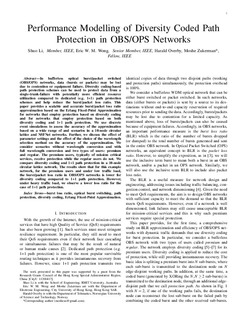| dc.contributor.author | Li, Shuo | |
| dc.contributor.author | Wong, Eric W M | |
| dc.contributor.author | Øverby, Harald | |
| dc.contributor.author | Zukerman, Moshe | |
| dc.date.accessioned | 2020-01-23T07:48:16Z | |
| dc.date.available | 2020-01-23T07:48:16Z | |
| dc.date.created | 2020-01-08T10:52:12Z | |
| dc.date.issued | 2019 | |
| dc.identifier.citation | Journal of Lightwave Technology. 2019, 37 (13), 3138-3152. | nb_NO |
| dc.identifier.issn | 0733-8724 | |
| dc.identifier.uri | http://hdl.handle.net/11250/2637553 | |
| dc.description.abstract | In bufferless optical burst/packet switched (OBS/OPS) networks, data (bursts or packets) may be lost due to contention or equipment failure. Diversity coding-based path protection schemes can be used to protect data from a single-trunk failure with potentially more efficient resource utilization compared to dedicated (e.g., 1 + 1) path protection schemes and help reduce the burst/packet loss ratio. This paper provides a scalable and accurate burst/packet loss ratio approximation based on the Erlang fixed-point approximation for networks that employ protection based on diversity coding and for networks that employ protection based on both diversity coding and 1 + 1 path protection. We use discrete event simulations to assess the accuracy of the approximation based on a wide range of scenarios in a 10-node circular lattice and NSFNet networks. Further, we discuss the effect of parameter settings and the effect of the choice of the wavelength selection method on the accuracy of the approximation. We consider scenarios without wavelength conversion and with full wavelength conversion and two types of users: premium and regular. The premium users, typically of mission critical services, receive protection while the regular users do not. We compare diversity coding and 1 + 1 path protection in a 10-node circular lattice network. The results show that for this example network, for the premium users and under low traffic load, the burst/packet loss ratio in OBS/OPS networks is lower for diversity coding compared to 1 + 1 path protection. However, under heavy traffic load, we observe a lower loss ratio for the case of 1 + 1 path protection. | nb_NO |
| dc.language.iso | eng | nb_NO |
| dc.publisher | Institute of Electrical and Electronics Engineers (IEEE) | nb_NO |
| dc.title | Performance Modeling of Diversity Coded Path Protection in OBS/OPS Networks | nb_NO |
| dc.type | Journal article | nb_NO |
| dc.type | Peer reviewed | nb_NO |
| dc.description.version | acceptedVersion | nb_NO |
| dc.source.pagenumber | 3138-3152 | nb_NO |
| dc.source.volume | 37 | nb_NO |
| dc.source.journal | Journal of Lightwave Technology | nb_NO |
| dc.source.issue | 13 | nb_NO |
| dc.identifier.doi | 10.1109/JLT.2019.2911651 | |
| dc.identifier.cristin | 1768354 | |
| dc.description.localcode | © 2019 IEEE. Personal use of this material is permitted. Permission from IEEE must be obtained for all other uses, in any current or future media, including reprinting/republishing this material for advertising or promotional purposes, creating new collective works, for resale or redistribution to servers or lists, or reuse of any copyrighted component of this work in other works. | nb_NO |
| cristin.unitcode | 194,63,30,0 | |
| cristin.unitname | Institutt for informasjonssikkerhet og kommunikasjonsteknologi | |
| cristin.ispublished | true | |
| cristin.fulltext | postprint | |
| cristin.qualitycode | 1 | |
